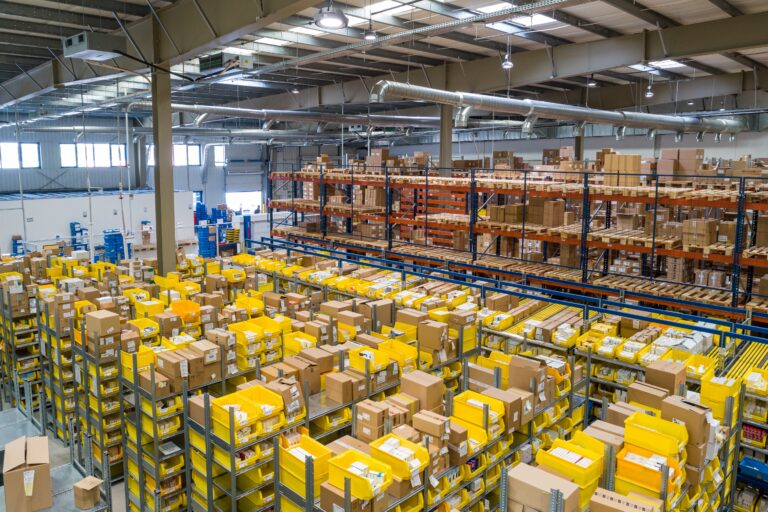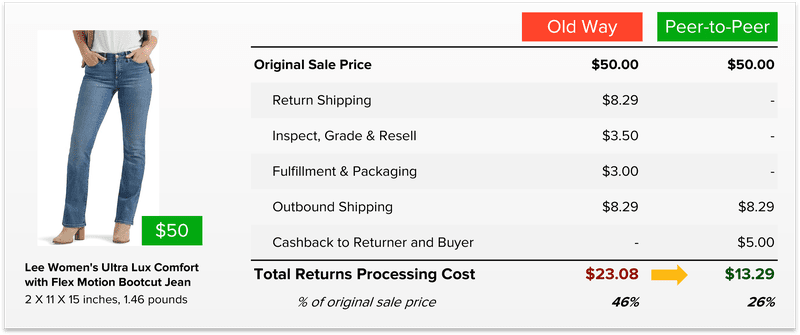How to Choose the Best 3PL for Wayfair

Last updated on February 18, 2025

Wayfair is commonly referred to as the “Amazon of the Furniture and Home Goods” industry. Wayfair has over 22 million active customers; while this may seem a small number compared to the number of people shopping at the likes of Amazon and Walmart, Wayfair is focused on a specific niche. Wayfair has managed to retain its dominance in the Furniture and Home Goods category despite these massive competitors. Wayfair brings in $2.9+ billion in revenues each quarter.
Wayfair’s business model is similarly unique. While Amazon has invested heavily in building its inhouse logistics network and Walmart and Target are slowly growing ecommerce in addition to the brick and mortar channel that fueled their growth, Wayfair is different. Wayfair relies heavily on a dropshipping model. In this model, when Wayfair customers place orders, the orders are sent directly to sellers to be picked, packed, and shipped. According to estimates, Wayfair dropships as much as 95% of the products that it sells to customers. This reliance on dropshipping makes efficient fulfillment services essential for Sellers working with Wayfair to ensure timely delivery and customer satisfaction.
Why Selling on Wayfair is Great for Ecommerce Merchants
Wayfair offers unique selling opportunities for sellers that other marketplaces don’t.
Lesser Competition Than on Other Marketplaces
As of 2023, Wayfair has only 11,000 3rd party sellers, which is miniscule compared to the 2.5 million 3rd party sellers on Amazon’s marketplace and still very low compared to the 150,000 on Walmart. This allows brands to be much more prominently featured and visible to customers, enabling increased sales and profitability.
No Marketplace Referral Fees
Wayfair buys products from its suppliers at wholesale prices and then charges retail prices to its end customers. This can be a more attractive model to sellers, compared to the referral fee based model that Amazon operates on.
Wayfair Covers Shipping Fees
Like other marketplaces, Wayfair covers the cost of shipping for its sellers: all shipments are billed to Wayfair’s Small Parcel (FedEx), LTL or White Glove shipping accounts. Merchants can either choose to use prepaid shipping labels from Wayfair or print their own shipping labels and then bill Wayfair for the associated charges.
“Cahoot has a great app and tech platform for e-commerce and has been a great partner. I evaluated numerous competitors and they provided by far the most compelling combination of good pricing and service. Their people are top-notch and there to help you succeed as a partner.”
~ VENTAPAK
Speak to a fulfillment expert
Issues and Problems with Selling on Wayfair
Selling on Wayfair can be lucrative but there are challenges and downsides sellers must navigate. Here are some of the most common issues and problems sellers face:
1. Wayfair Controls Final Pricing
Unlike other marketplaces where sellers set their own prices, Wayfair includes the shipping cost in the customer facing price meaning they control the final retail price.
2. Automated Pricing Algorithm
Wayfair uses an automated algorithm to adjust listing prices dynamically. This can lead to unpredictable price changes and lower margins without seller consent.
3. Price Competition
Large brands and established manufacturers dominate product categories, along with many sellers adopting a low price, high volume strategy, making it difficult for new sellers to gain visibility.
4. Listing Visibility
Wayfair’s search algorithm prioritizes best-selling products and established sellers. Wayfair does not allow SEO or paid ads to boost visibility. As a result, newer sellers often struggle to get noticed.
5. No Branded Storefronts
Unlike on Amazon and Walmart, Wayfair does not allow sellers to create branded storefronts. This limits a seller’s ability to build brand recognition and customer loyalty, as all products are displayed under Wayfair’s branding rather than the seller’s business identity.
6. Strict Policy Compliance
Sellers must adhere to Wayfair’s stringent policies regarding product quality, shipping times, and return policies. Failing to comply with these regulations can result in penalties, product delistings, or even account suspension.
7. Customer Service
Wayfair requires sellers to provide rapid responses to customer inquiries. Delays in communication or failure to resolve customer issues promptly can negatively impact a seller’s standing on the platform.
8. Strict Listing Requirements
Wayfair has rigid listing guidelines that sellers must follow. These include detailed product descriptions, high-quality images, and accurate specifications. Listings that do not meet Wayfair’s standards may be rejected or removed from the platform.
9. High Return Rates
Wayfair has a customer-friendly return policy, which often translates into higher return rates for sellers. Since sellers are responsible for handling returns and associated costs, frequent returns can erode profit margins and create logistical challenges.
10. Large Item Shipping Challenges
Wayfair specializes in home goods, furniture, and large items, which can present shipping challenges. Sellers must ensure proper packaging, coordinate with freight carriers, and manage potential damages during transit. Shipping delays or damage claims can lead to customer dissatisfaction and financial losses.
11. Market Fluctuations
The home goods and furniture industry is highly susceptible to market fluctuations, seasonal demand shifts, and economic downturns. The US housing market also impacts customer demand for furniture and home goods. These factors can affect sales volume, pricing stability, and overall profitability for sellers on Wayfair.
What to Look for in a Wayfair 3PL?
Sellers participating in Wayfair can be profitable, but requires careful planning. Sellers must manage logistics, pricing, and meet Wayfair’s standards and regulations. This can be overwhelming and partnering with an experienced 3PL can ensure participation with Wayfair is profitable and stress-free. Here are some of the features a 3PL provides:
Automated Inventory Level Monitoring
Sellers on Wayfair are encouraged to send Inventory Feeds (updates on how much stock of product is available at warehouses) as frequently as possible. This is because Wayfair wants to ensure a good customer experience by only shipping products that are in-stock.
With traditional 3PLs, stockkeeping of inventory levels is often conducted on spreadsheets, or worse, by hand. These inefficient tools create many problems in staying on top of the inventory levels in warehouses.
If a business takes on more orders than it can fulfill, fails to ship all assigned orders, and is forced to cancel, it can damage relationships with both Wayfair and customers. Such cancellations may lead to penalties, loss of trust, and a negative impact on future sales opportunities.
With Cahoot’s intelligent software, inventory is automatically decremented and provides color-coded alerts as inventory starts running out of stock – this ensures proactively replenishing inventory and boosting sales, rather than scrambling to fix problems.
Ability to Offer Late Same Day Cut Offs
Wayfair encourages sellers to deliver a great experience to their customers by ensuring that order cut-off and shipment pickup times are set as late as possible, so that customers can experience fast shipping. This might also be Wayfair’s attempt to keep themselves competitive and relevant in the era of ultrafast fulfillment.
Most traditional 3PLs struggle to meet the demanding expectations from today’s customers. Cahoot is used to meeting expectations for late same-day cutoffs, weekend pickups and deliveries through our expertise in helping Amazon sellers thrive on the Seller Fulfilled Prime (SFP) program. Through our network’s best-in-class fulfillment capabilities, sellers meet and surpass the expectations of Wayfair customers.
Minimum Lead Time – Every SKU Ships Fast

If an order containing different SKUs needs to ship in separate shipments, Wayfair expects merchants to proactively communicate that to customers. However, today’s demanding customer expects ultrafast order fulfillment across every SKU. To meet these expectations, shippers must ensure their 3PL deploys excellent pick-pack practices, have high-quality fulfillment services, and order fulfillment operations in their warehouses.
Consider working with a partner like Cahoot – to fulfill orders for our sellers, a warehouse must pass a 44-point checklist. This ensures that only the very best fulfillment centers join our network. These fulfillment centers are well equipped to handle a variety of SKUs – small, light, slow and fast-moving, heavy, larger-sized and seasonal.
“I highly recommend Cahoot to anyone looking to outsource fulfillment for their business. They go above and beyond to help make sure your needs as a business are met. I reached out to 20 other 3PLs, and fulfillment centers. Cahoot was the best option for business relations, services, and pricing by far.”
~ GN Products LLC
Speak to a fulfillment expert
Responsive, Reliable Customer Support

Needless to say, order fulfillment is a complex operation, and things don’t always go to plan. When issues arise, customers and Wayfair won’t blame the 3PL; the merchant is held accountable and the merchant’s relationship and brand equity is at stake with these key stakeholders. While setbacks can occur, it is crucial to ensure that the 3PL offers responsive and reliable customer support to address problems swiftly and restore normal operations with alacrity.
Most traditional 3PLs lack personnel with either the experience or expertise required to quickly troubleshoot issues. It is essential to identify 3PLs with a dedicated and qualified support team ready on hand to resolve problems, ensuring business operations remain uninterrupted and increasing in sales volume and profitability.
Cahoot – The Best 3PL for Wayfair
Cahoot’s peer-to-peer order fulfillment network is built for the future of ecommerce. Our network of warehouses is located at strategic locations across the US, enabling Wayfair merchants to offer their customers ultrafast shipping. Our fulfillment centers are well equipped to handle all types of SKUs – including heavier, seasonal, larger-sized and slow moving ones. Cahoot’s services come with transparent pricing and no hidden fees.
Cahoot is compliant with all expectations Wayfair has from its dropshippers. Our US based customer support team is always ready and responsive to ensure that order fulfillment operations are running smoothly at all times. Cahoot is committed to helping Wayfair sellers grow their businesses with fast and affordable ecommerce order fulfillment service.
To find out how Cahoot can help ecommerce businesses grow, please get in touch with us. We can’t wait to show how Wayfair order fulfillment was meant to be. Businesses selling on multiple sales channels can also see how Cahoot can help with fulfillment in our other articles:
- How to Choose the Best 3PL for Shopify
- How to Choose the best 3PL for Macy’s Orders
- How to Choose the Best 3PL for Target Plus
- How to Choose the Best 3PL for the Nordstrom Direct Dropship Program
Frequently Asked Questions
Is Selling on Wayfair Worth it?
Selling on Wayfair can be worth it for businesses that specialize in home goods, furniture, and décor. The platform provides access to a large customer base, but it operates differently from traditional marketplaces like Amazon or eBay. Wayfair uses a drop-ship model, meaning sellers don’t directly sell to customers but instead supply products that Wayfair markets and sells.
How do I Sell on Wayfair?
Wayfair does not allow just anyone to list products. First, sellers need to submit an application to the Wayfair Partner Program and be approved.
What is a Wayfair 3PL?
A Wayfair 3PL (Third-Party Logistics) provider is an external company that handles warehousing, fulfillment, and shipping on behalf of Wayfair suppliers. Since Wayfair operates on a drop-ship model, many sellers use 3PL services to manage storage and deliveries efficiently. This helps meet Wayfair’s strict shipping requirements, improve delivery speed, and reduce logistics costs.
How Much Does It Cost to Ship for Wayfair?
Wayfair typically covers shipping costs but requires sellers to price their products accordingly to absorb these costs. There are no direct shipping fees to Wayfair, but suppliers are responsible for ensuring competitive pricing that includes fulfillment expenses.

Up to 64% Lower Returns Processing Cost


 10 minutes
10 minutes